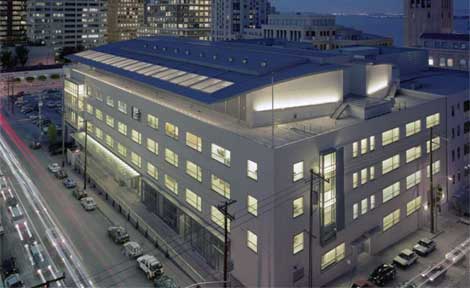
The 365 Main flagship data center in San Francisco.
How do you engineer a data center for high availability in an earthquake zone? That's a special challenge in San Francisco, which is home to a vibrant community of Internet businesses but experienced widespread devastation from a 1906 quake and sustained another big hit in the 1989 Loma Prieta ("World Series") earthquake.
365 Main houses mission-critical equipment for more than 200 companies in its data center nestled alongside the Bay Bridge. When original owner AboveNet was converting the former tank turret factory for data center use in 2000, it confronted the earthquake risk, installing a base isolation designed to keep the entire building stable when the earth moves.
"This is one of the safest buildings in San Francisco," said Miles Kelly, senior VP of marketing for 365 Main.
Many data center companies use rack-level earthquake isolation units, which are installed under racks and cabinets and employ a ball-and-cone system to allow the equipment to gently roll back and forth during an earthquake. Providing earthquake protection at the building level involves similar concepts, but a lot more engineering.
The 365 Main building is built atop bedrock, and the 98 columns supporting the building are equipped with the base isolation systems, which are visible in the facility's underground parking garage. Each of the massive columns is topped with a special joint known as a "friction pendulum" consisting of a plate and rubber bearings that absorbs the shock created by seismic movements. (See this video for an overview of a similar system).
A "Floating" Building
In an earthquake, this will allow the entire building to effectively float above the shifting ground beneath it. The piping, cabling and utility connections join the building above the isolation joints to protect their integrity in the event of an earthquake.
The seismic engineering extends outside the building, which is surrounded by an 18-inch wide "mini-moat" that will allow the sidewalk areas to fold and absorb the shock of a large quake.
Like many large metro-area data centers, 365 Main would be a priority customer for diesel fuel deliveries to keep the facility online after a disaster. The city of San Francisco has granted 365 Main "essential facility" status, allowing continued occupancy without the inspections required of buildings with less sturdy quake protection.
365 Main was formed to operate the San Francisco data center after AboveNet filed for bankruptcy in 2003. Rockwood Capital, which owns the building, has backed 365 Main in an expansion that has created a national network of five data centers, including California facilities in San Francisco, Oakland and El Segundo (LA market) as well as Chandler, Arizona and Chantilly, Virginia. The company also owns a property in Newark, Calif. for future expansion.
Retail vs. Wholesale Space
The San Francisco facility is unique in 365 Main's portfolio in its retail colocation model, leasing cabinets and cages directly to customers. In its other markets, 365 Main employs a wholesale data center model, leasing large chunks of data center space to customers, who can use it for their own operations or to sell cabinets and cages to others.
Each of 365 Main's buildings is designed with pods of 10,000 to 12,000 square feet of spoace. There are eight pods in the 227,000 square foot San Francisco facility. Kelly said 93 percent of available floor space is filled, but the facility is at 98 percent of its power capacity. During the 2000 retrofit, the company added a fifth floor to house generators and rotary UPS units.
The generators continue to be a point of interest for prospects aware of a 2007 outage resulting from the failure of multiple generators. But Kelly says the company's response, including the release of an unusually detailed incident report, helped 365 Main implement additional procedures to ensure the generators' reliability.




